[In yet another submission for the “Oops! We did it again” file, I accidentally published an unfinished draft of our 2017 Kawasaki SX-R JetSki review full of disjointed thoughts, incomplete sentences and a whole lot of mistakes. For those who already read our previous version, I apologize. For those who liked it, we question your sanity. – Ed.]
“Yeah, I know,” I grumbled to yet another friend who had taken the new ski out for their first time. I had already heard how fast the 2017 Kawasaki SX-R JetSki was from far too many sources, and for whatever reason, every single one of them felt inclined to call and tell me about it. All but completely mockingly, I parroted, “It’s faaast!” I won’t lie, I was kind of sick of hearing about it over the past six months – between today and the time we revealed to the world that the SX-R would be returning last September. Admittedly, I was bitter. (No duh.) Everywhere I looked, international media outlets were riding the new standup, but for whatever reason, all of the American media was virtually shut out. Was Kawasaki afraid of what we would say? Maybe I was being impatient. Yeah, I knew I was.
Kawasaki’s resurrection of the standup was something of an enigma in and of itself. And offering a 62-mile-per-hour standup from the factory made the decision less of a mystery and more of a questioning of the company’s sanity. Yes, the SX-R was fast. Despite its 551-pound heft, the 160-horsepower 1,496cc 4-stroke pulled from the STX-15F could deftly propel the new SX-R to Pro Open speeds without breaking a sweat – I had little doubt about that. What concerned me more than its ability to out accelerate the supercharged 310-horsepower Ultra (which it can), was whether the SX-R retained much of its predecessor’s soul. The lingering ghost of the SX-R 800 still haunted the corners and hallways of people’s nostalgia, and all wanted Kawasaki to provide a worthy successor. The long delay in revealing the ski gave many supposed reason to doubt, be it unfounded or otherwise. Admittedly (again), I was one of those.
And why not? The SX-R 800 was a huge success for Kawasaki, from its introduction in 2003 until its untimely “retirement” in 2011. In fact, it was one of my personal favorite standups and is still the benchmark for many aftermarket ski builders. The new SX-R on the other hand, appeared to be more runabout than standup. Even I got caught up in the “standabout” name calling among friends. When compared, the new SX-R outweighs the previous SX-R 800 by nearly 150-pounds. (Heck, it’s 130-pounds heavier than a 3-seater Sea-Doo Spark.) The new ski was also 14-inches longer, with only a slight expansion in width, and another 3-plus-inches in height above the old 800. But history has a way of hiding truths; the 800’s introduction back in 2003 was nearly as upsetting as the new SX-R today. The 800, when compared to the then-standard SXi Pro, was enormous, and considerably over-powered. The comparison felt palpable.
In fact, it was this predisposition that equated for my initial humbling. Observing how much hull resided below the bondline, I had wrongly presumed the SX-R would all but buoy like a pontoon. It didn’t, and dozily rolled over as I confidently threw a knee into the tray. The hull, and the entirety of the new SX-R, is deceptively well-balanced. In fact, the amount of draft was easily explained by Kawasaki standup guru and principal developer, Minoru Kanamori: “We had to place the engine as far down as possible in case it rolls over. With [the engine] so low, it will naturally roll back over.” He continued, “The lower the center of gravity, the better the stability both in the ocean and in the closed course. It makes it more stable and easier for everybody to ride.” And chop is where the SX-R shines brightest. Before, even rolling waves would give us reason to fear on smaller standups but not the SX-R. Simply charge ahead, rollers be damned.
Firing up the ignition spurs an unfamiliar, almost disquieting burble from beneath the hood. Although I consciously knew the 1,496cc 4-stroke powered the ski, hearing the muffled exhaust note was unsettling. That doesn’t sound right. My lizard brain’s inner monologue observed; half expecting the cacophony of a pinging 2-stroke. At idle, the 15F’s transplanted pump churns gently and a lack of blue premixed exhaust instinctively made me question whether the ski was still firing. It was in fact, and was ready for me to wake up. After my stupid bobble, I pulled myself back aboard, pinched the mechanical cable-driven throttle, and let the SX-R’s acceleration reveal itself. Unlike the Eaton-supercharged Ultras 310s, the SX-R’s acceleration comes on linearly, giving only as much as you ask it. With 160-ponies on tap, I feared the throttle would be jarring. Gratefully, such was never the case. Sure, there is arm-stretching acceleration at the ready, but the 60mm throttle body never once threw me a surprise.
Feeling brave, I decided to open her up. Tucking in low, staggering my feet, I pinned the gas. And it was…weirdly uneventful. Sure, going that fast on a ski is amazing and will definitely alert all of your senses, but at no time did the SX-R do anything wonky. No chine walk or searching. At speed the SX-R tracked true, behaved predictably and well-balanced. No standup we had ridden before acted so calmly at such speeds. It simply went faster. While there was no time that I forgot the size of the craft I was riding, it never felt big, unruly or insulated. It never hunted or darted side-to-side. The steering input was responsive, responding sharply, but measured. In fact, in the corners, it only wanted more: more throttle, more lean-in. In fact, almost at all times did it beg for more throttle. Whether sluicing through chop or in the corner, the SX-R wanted more gas. Let’s go faster, it begged. C’mon, we can take this turn twice as fast.
Despite its curvaceous profile, the compounding angles, alcoves and curves, the entirety of the SX-R is somewhat spartan. What innovation exists does so out of necessity, all other conveniences or flourishes were left on the cutting room floor. The teardrop-shaped chin pad on the handle pole features an amber gas warning light and a all-encompassing red engine warning light indicating oil pressure/engine temperature. A magnetic safety key acts as a security kill switch and can be tucked under the snap-together rubberized cargo net atop the hood. Gray Hydro-Turf mats are plush and serve well. Gone are the soft padding from atop the gunwales, which I missed considering how many times I found myself reboarding throughout the day. A foam-lined chest pad wraps around the electroplated handlebars, serving as a small pull-up bar when heaving oneself back into the tray. We hoped for a little more panache given the ski’s return after its 6 year hiatus, but costs were kept to a near zero. In fact, far more than we ever could expect.
Kawasaki’s Off-Road and Watercraft Product Manager Dave Oventhal was graciously candid with The Watercraft Journal. When I prodded why Kawasaki would choose to resurrect the SX-R when manufacturers were doubling down on Rec Lite-segment (Spark, EX) runabouts, Oventhal admitted, “Trust me, we’re not ignoring them. But we decided [it was best] to do something different.” While walking to the beat of one’s own drum is commendable, we did question Kawasaki’s motives. He replied, “It wasn’t just about reclaiming existing market share, we’re an enthusiast company first. We wanted to build something we loved too. And that was a [standup] JetSki.” Moreover, Oventhal admitted that developing a “Spark fighter” would require millions in development compared to the opportunity of creating a 4-stroke standup not from whole cloth, but from a majority of pre-existing components. “You’d be very surprised has how few parts were specifically designed and created for [the SX-R] from scratch.”
In one instance, Kanamori discovered that after months of trial-and-error, the sponsons found on the STX-15F were actually better suited for the SX-R than any one of the prototypes he had been developing. “That sponson is 100-percent identical to the STX-15F. Same bolt pattern. Everything,” he laughed. The air box, criss-crossing air inlet tubes and even the flush kit hose adapter all came from the STX as well. Building a machine from so many existing components worked to keep the MSRP price below $10,000. “That was a big goal for us,” Kawasaski’s Jon Rall smiled. “We knew we had to keep the price down if we wanted to be taken seriously [by many of the JetSki diehards].” And that’s what Kawasaki is hoping for; thus far, Kawasaki reports that 80-percent of SX-R buyers are recreational riders with some previous standup or PWC experience, with 20-percent belonging to dedicated racers. The hope is that the racing segment will inspire new and returning buyers to rekindle their love affair with the standup JetSki. And given the SX-R’s out-of-the-box race-readiness, the asking price is right where it needs to be.
It’s an impressive thing to see Kawasaki put all of its passion back out on the table again. The SX-R is a valid entry, regardless of how many other machines its made from. In fact, it really shouldn’t matter at all. The machine is now entirely 50-stage legal, as well as legal in several countries it couldn’t have been sold in before, and it’s an absolute blast to ride. And yes, it’s a workout and for those of us who could bare to lose 5-to-50 pounds, it might be the only gym membership you’ll be willing to buy. There’s no doubt that Kawasaki will sell every SX-R they build this year; the big question is what will next year (and the year after) look like. Will this 4-stroke SX-R reignite the standup industry? We definitely believe it has what it takes.





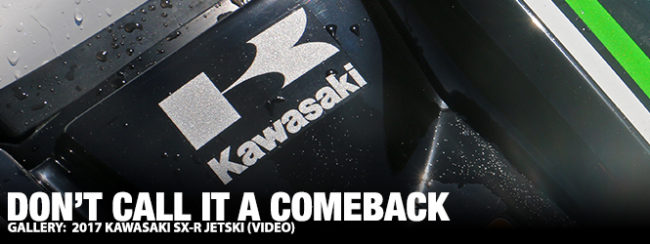
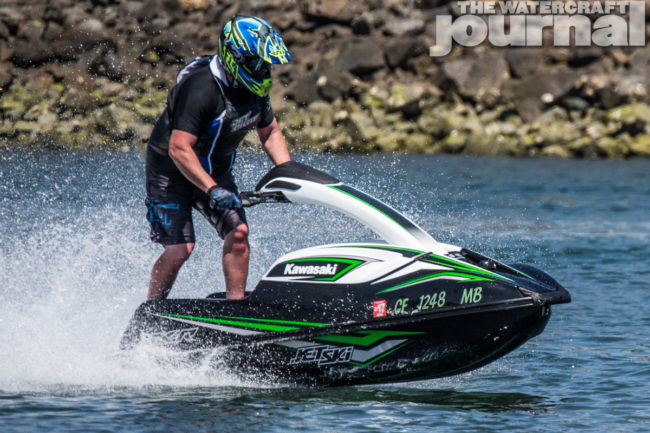
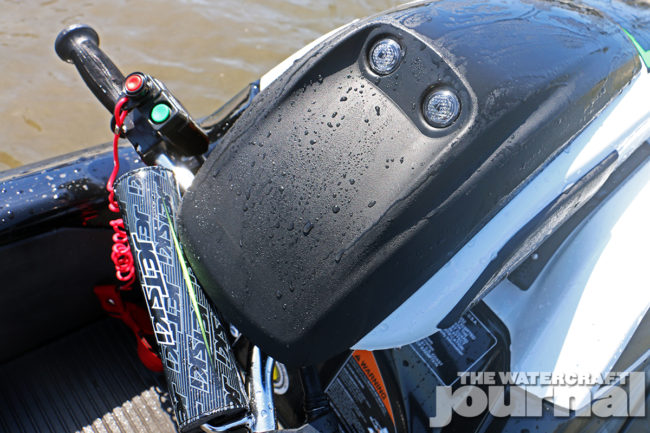
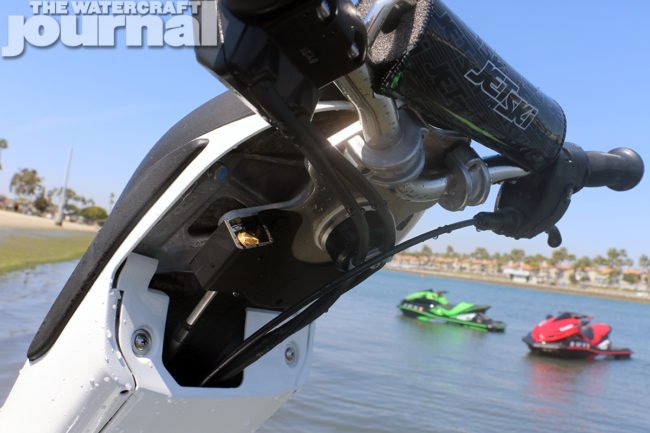

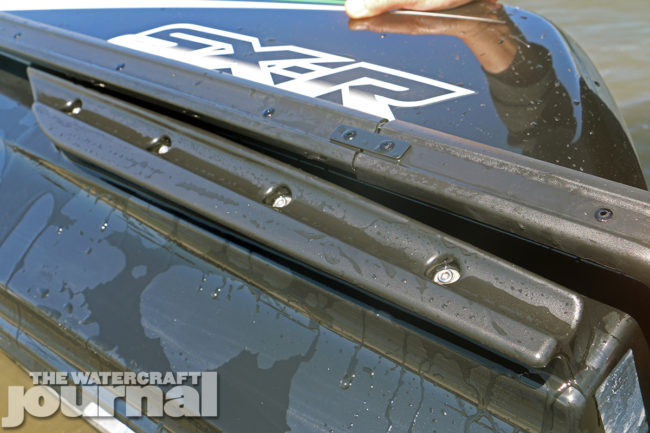
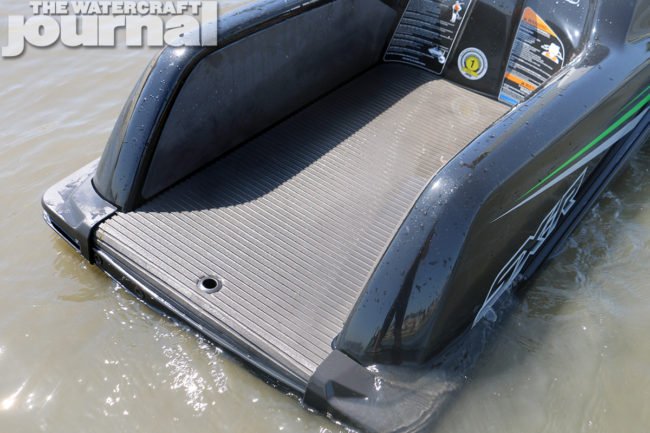



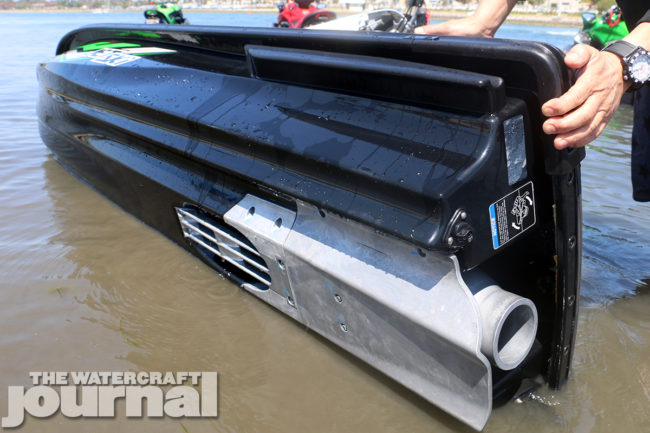

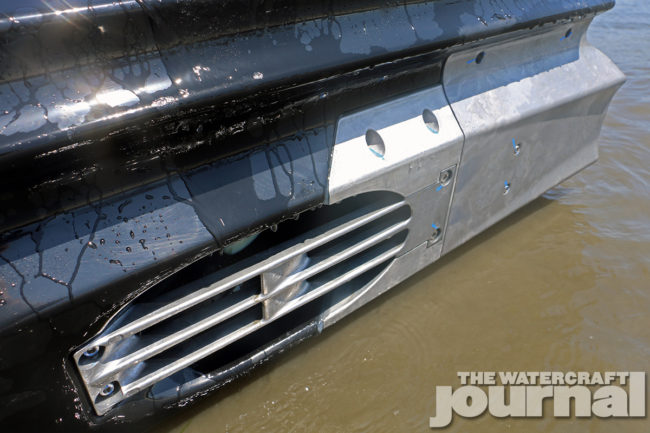
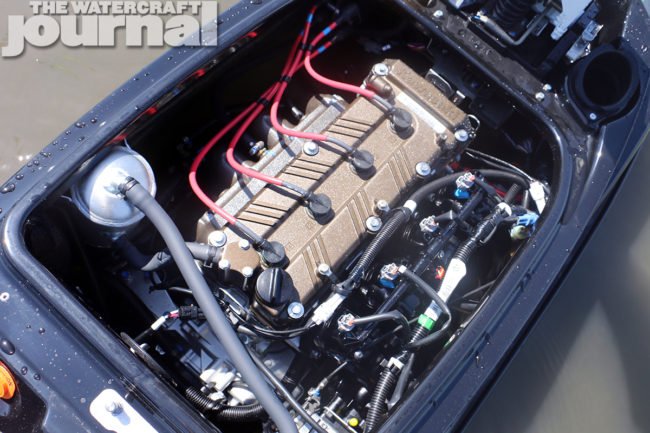
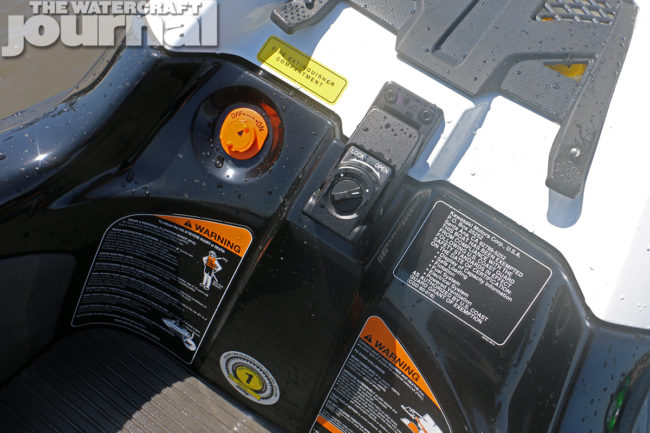

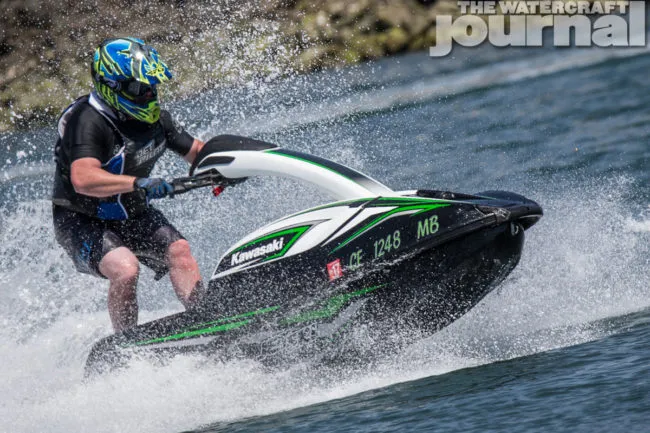























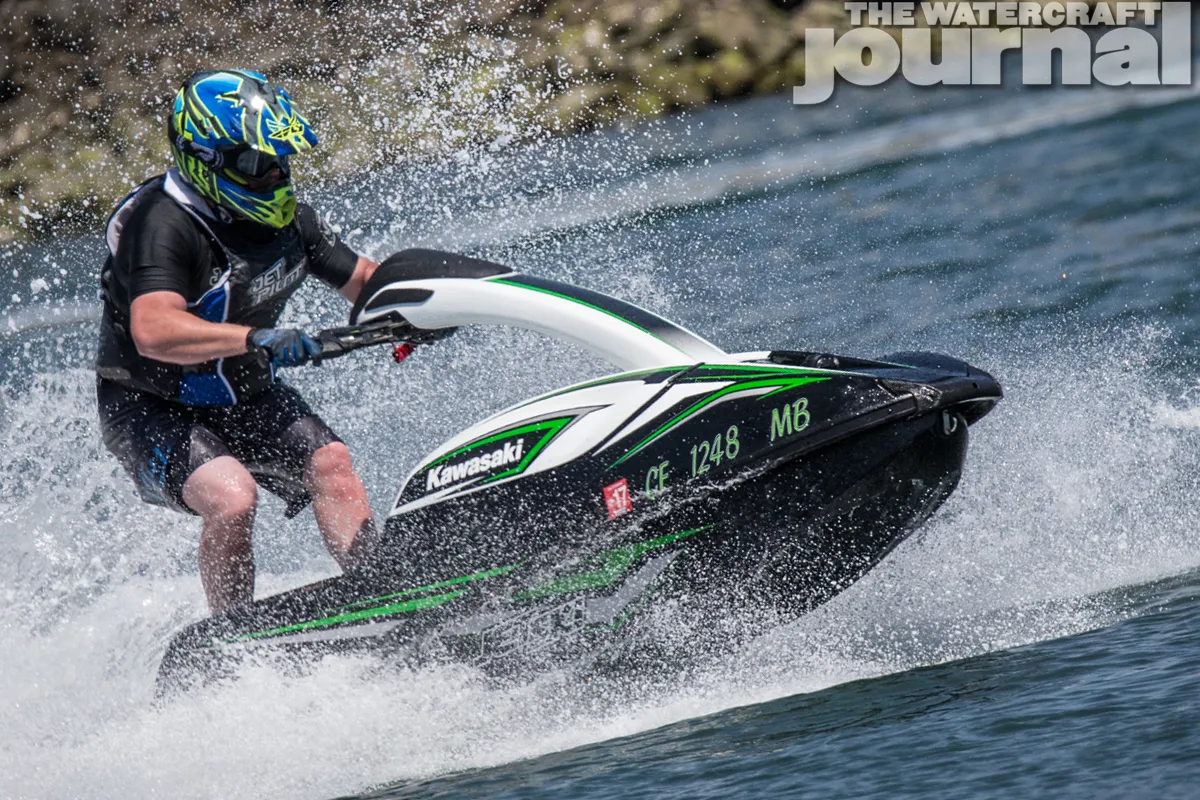



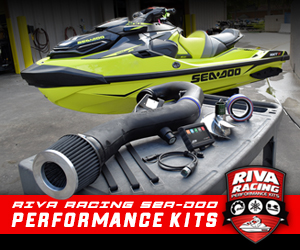
Any indication from management of where they will go with the ultra? A bigger version of the SXR hull with the Eaton supercharger along with an IBR would make a real speed demon for a new ultra. I hope Kawasaki invests in the sit downs and brings real competition to the RXT X and the FX SVHO in terms of modified speeds. Good read!
Right now, all indicators are Kawasaki focusing on securing the SX-R’s foothold in the racing market and expanding its appeal to powersports enthusiasts (mainly dirt bike riders). Once a steady stream of income is established will Kawasaki work at expanding its runabout range into other market segments. Kawasaki’s Off-Road & Watercraft Product Manager Dave Oventhal did let loose that they were working on a braking system and “we’re going to do it right.” Next on that list is appealing to one of the most vibrant segments, naturally-aspirated cruisers. We’re banking on a well-equipped Ultra LX before we see revisions to the 310R or X models.
I hope they do something soon to keep the ultra competitive. For those who want to mod, there’s not many options to get the Kawi going over 74 MPH. Braking should be standard today. I hope they do something soon or I may be an RXT x owner. I’m trying to stay loyal to kawi but without them investing in the most popular part of the industry many of us are looking elsewhere. The stand up is awesome and I wish them luck but i wish they would invest in their ultra 310.
A flashed RXT is running 76 MPH and almost 80 at with stage 2 with only a few mods.